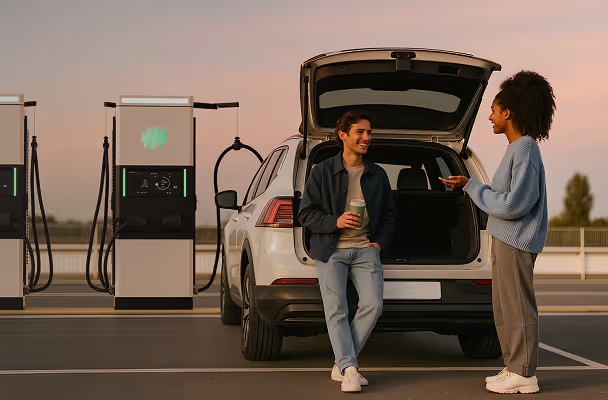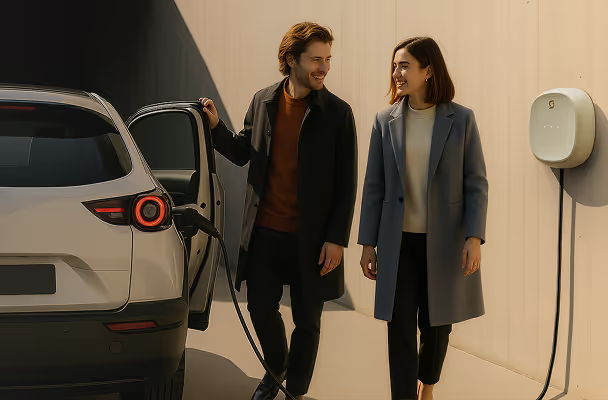Global futurism in home EV charging: Powering the next revolution

Imagine your journey back home after a tiring day at work. Your car is in dire need of refueling, much like you. But you don’t go to the petrol pump to wait in long queues. You don’t inhale toxic fumes on crowded highways. Instead, you pull into your driveway. You arrive at your spot in front of the streetlight, right next to the garden. Your car automatically starts charging. The electricity for this? Generated from the sunlight that fell on your driveway that afternoon. Two hours later, a notification on your phone tells you that your car is fully charged and ready for the morning.
This is not a distant dream. It is the future of home EV charging: seamless, smart, sustainable. Around the world, electric vehicles (EVs) are reshaping mobility through their eco-friendly, convenient, and cost-effective functioning. Home charging an EV is particularly useful. It is cheaper than using fossil fuels, and the infrastructural requirements are also lower.
Developed countries like the US, China, and the European Union are accelerating EV adoption by offering tax benefits and construction support for home charging infrastructure.
India is catching up fast. The government targets 30% EV penetration by 2030. Home charging of EVs is being heavily promoted to reach this goal. The Ministry of Power’s 2024 guidelines allowed individuals to install private home chargers without needing separate licenses, easing adoption. Maharashtra’s EV Policy 2025 mandated EV charging facilities in new residential and commercial buildings and offered incentives for existing housing societies to install chargers. Delhi’s subsidy scheme, in partnership with Tata Power-DDL, reduced installation costs for electric two- and three-wheelers to just ₹2000 - 3000.

With this overwhelming response, it is only natural that many futuristic developments have happened in the home-charging of EVs. How are visionary technologies defining this future?
The future of home EV charging is being shaped by these top 6 technologies
The hope for the future lies it in being better than the present. At present, there are insufficiencies in installation and usage convenience, adaptability, accessibility and clean energy usage, when it comes to EV charging. Let’s take a look at how these 6 technologies will solve them.
1. Solar-powered charging enables 100% clean energy usage right from home.
Solar-powered home chargers allows EV owners to harness renewable energy directly. This reduces grid dependency, lowers electricity bills, and cuts carbon emissions. This also enables remote areas with limited power grids and petrol pumps to have seamless mobility by charging EVs through solar power. India and Australia are pioneers in this space, with companies such as Tata Power in India and Sunsave Energy in Australia actively promoting solar EV charging solutions.
2. Charging via street light infrastructure simplifies installation
Even though the architectural requirement for installing a home EV charger is low, in today’s time, it still requires specialized wiring. That may not be possible for every home to incorporate. Innovative concepts are turning streetlights into EV charging points, giving each home a dedicated, nearby power source. This development is especially promising for dense urban areas and apartment complexes where home charging installation faces space and infrastructure constraints. By leveraging existing municipal infrastructure, this technology can democratize EV charging access and reduce installation complexity. London (UK) and Los Angeles (USA) are leading cities implementing streetlight EV charging programs. Companies like Omniflow and Galp Electric are at the forefront, transforming streetlights into smart EV charging hubs.
3. Inductive (wireless) charging will create unbelievable ease in access
This technology uses the principle of resonant inductive coupling. When parked, alternating current (AC) electricity runs through a transmitter coil embedded in the pavement, which creates an oscillating electromagnetic field. A corresponding receiver coil in the EV resonates at the same frequency as the transmitter coil. It captures this magnetic energy and converts it into direct current (DC) to charge the battery. This energy transfer doesn’t require charging cables. This means there is no need to physically plug anything in. No manual effort, and no additional costs or risks due to cable wear and tear. While still emerging globally, inductive charging represents the pinnacle of user convenience and is expected to gain traction in urban residential settings. South Korea and Germany are early adopters, with companies such as WiTricity and HEVO Power developing commercial wireless charging solutions for urban residential and commercial use.
4. AI/ML-enabled predictive charging is key to intelligent energy management for charging
Artificial intelligence and machine learning optimize charging schedules based on electricity tariffs, grid load, user habits, and weather patterns. Predictive algorithms are able to access customer charging patterns, energy provider signals, and accessibility to renewable energy. They thus minimize costs by scheduling charging during off-peak hours and reduce grid stress by balancing demand. United States and State Grid Corporation of China are pioneers in AI integration for smart energy management.
5. Vehicle-to-everything (V2X) power sharing will transform EVs into energy assets
V2X technologies, commonly including Vehicle-to-Home (V2H), Vehicle-to-Grid (V2G), and Vehicle-to-Vehicle (V2V) enable EVs to supply power back to homes, to other vehicles, or the grid. This bidirectional flow stabilizes energy supply, provides backup power during outages, supports renewable integration, and offers unparalleled customization. As India’s grid modernizes, V2X will empower EV owners to become active participants in energy markets, potentially earning revenue while enhancing grid resilience. Japan and Netherlands are pioneers in V2X deployment, with companies like Nuvve and Toshiba advancing commercial V2G and V2H solutions.
6. Multi-life, multi-purpose batteries will minimize chemical waste and create additional savings
Repurposed EV batteries are being increasingly used in home energy storage systems paired with solar and charging infrastructure. These systems store excess renewable energy and provide reliable power, increasing resilience, and reducing costs. By integrating storage with charging, homeowners can optimize energy use, reduce peak demand charges, and enhance sustainability. Germany and United States lead in second-life battery applications, with companies such as Tesla and Siemens developing integrated storage and charging solutions.
These technologies will permanently change how we see vehicles and mobility – from polluting and painstaking, to sustainable and seamless. What remains to be seen, is how quickly they become the trend in India, and which manufacturers take the lead.
Exicom: driving the future of home EV charging
At Exicom, we are passionate about shaping the future of home EV charging with smart, sustainable, and future-ready technology. Our chargers are designed to seamlessly integrate with renewable energy sources like solar power. We leverage AI for intelligent energy management and support advanced features such as Vehicle-to-Grid (V2G) power sharing. We believe home charging should be effortless, efficient, and eco-friendly—empowering EV owners to charge faster, smarter, and greener. As India accelerates towards a cleaner mobility future, we are committed to delivering solutions that keep pace with global innovations and meet the evolving needs of Indian consumers. Join us in driving the zero-emission revolution with chargers built for tomorrow’s world.
Discover our range of future-ready home EV chargers here.
Bibliography
Equitymaster. (2025, January 2). 5 EV charging infrastructure stocks to add to watchlist for 2025.
EVreporter. (2025, May 16). List of top EV charging solution providers in India.
Alice Blue. (2025, April 7). Exicom vs Servotech - Which EV stock stands out?
Pulse Energy. (n.d.). Top EV charging station companies in India.
Frequently Asked Questions
Lorem ipsum dolor sit amet, consectetur adipiscing elit, sed do eiusmod tempor incididunt ut labore et dolore magna aliqua. Ut enim ad minim veniam, quis nostrud exercitation ullamco laboris nisi ut aliquip ex ea commodo consequat. Duis aute irure dolor in reprehenderit in voluptate velit esse.
Lorem ipsum dolor sit amet, consectetur adipiscing elit, sed do eiusmod tempor incididunt ut labore et dolore magna aliqua. Ut enim ad minim veniam, quis nostrud exercitation ullamco laboris nisi ut aliquip ex ea commodo consequat. Duis aute irure dolor in reprehenderit in voluptate velit esse.
Lorem ipsum dolor sit amet, consectetur adipiscing elit, sed do eiusmod tempor incididunt ut labore et dolore magna aliqua. Ut enim ad minim veniam, quis nostrud exercitation ullamco laboris nisi ut aliquip ex ea commodo consequat. Duis aute irure dolor in reprehenderit in voluptate velit esse.
Lorem ipsum dolor sit amet, consectetur adipiscing elit, sed do eiusmod tempor incididunt ut labore et dolore magna aliqua. Ut enim ad minim veniam, quis nostrud exercitation ullamco laboris nisi ut aliquip ex ea commodo consequat. Duis aute irure dolor in reprehenderit in voluptate velit esse.
Lorem ipsum dolor sit amet, consectetur adipiscing elit, sed do eiusmod tempor incididunt ut labore et dolore magna aliqua. Ut enim ad minim veniam, quis nostrud exercitation ullamco laboris nisi ut aliquip ex ea commodo consequat. Duis aute irure dolor in reprehenderit in voluptate velit esse.



